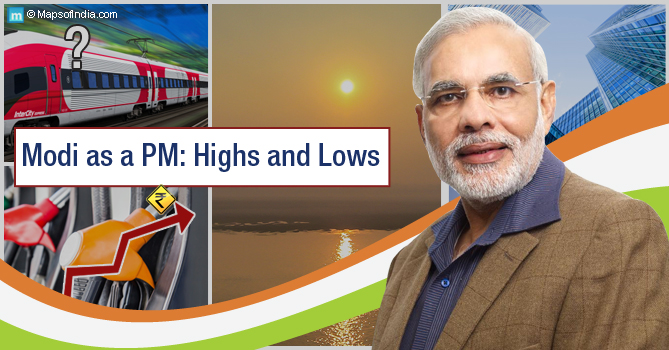It has been almost a year since Narendra Modi became the Prime Minister of India. How well he did as the PM will be evident when the elections are held again in 2019. However, starting from 26 May 2014, it could be said that he has had a memorable journey. When we try and assess how well he has done in this time period we will see that there have been decisions that have earned appreciation and there have been times when he has been criticised as well. He has been the face of India in many ways, just as he was the man solely responsible for the unprecedented victory achieved by BJP in the last assembly elections.
The Positive Side
The first budget presented by the Modi administration was in many ways indicative of what the PM wanted to achieve for India. He wanted to make India an urbanised and advanced country capable of comparing with the best countries of the world. In many ways this is representative of the modern day youth ethos – Hum Kisise Kam Nahin and he seemed to reflect that. For this purpose he started a number of projects. The Clean Ganga projects was started in order to clean the largest river in the country, while the main objective behind the Smart Cities project was to create 100 super cities in various parts of the country – make them hubs of economy, education and models of development.
The Swachch Bharat campaign looked to clean up the country’s roads and public places and keep it that way. The Make in India initiative was aligned with the Prime Minister’s aim to make the country a manufacturing powerhouse. The manufacturing sector once used to be a major provider of jobs in urban India only to be usurped by the service sector following computerisation. Defence was a major priority here. Modi wanted India to be a country that could sell weapons to other countries in the West. In order to make these projects, he has exhorted one and all to help in any way they can – financial aid, active participation etc.
On the diplomacy front, he gave equal importance to his immediate neighbours as well as global powerhouses like the US that share good ties with India. He chose to visit Bhutan and Nepal as his first foreign tours thus improving relations with these countries. Nepal needs to be mentioned over here considering how it complained of feeling neglected when the UPA was in power. He has also sought to improve relations with China, which is worthy of praise. Relations with Sri Lanka also seem to be better than what they were previously. He has also visited countries such as Brazil for the BRICS Summit, Australia and the US where the leaders have expressed their desire to engage in more fruitful collaborations with India, which is heartening to say the least.
He has also introduced a novel approach to politics by focusing on greater use of technology. Before he became the PM he had been especially active on Twitter and interacted directly with people. Post elections he has made all the government departments, functionaries, ministries and ministers stay active on the social media site. The former Gujarat CM feels that interaction and transparency can help bridge a lot of gaps, especially with the young minds, who also happen to be the biggest section of voters in India. He has himself shown the way.
The Not So Positive Side
It is said that often a man’s biggest weapon can become his weakest point. One of the main reasons that Indian voters en masse chose him was because they bought into his dream of modernization and of being able to compete with any country of the world. Modi has announced a number of projects but unfortunately none of them have started working. Funds are also a major source of worry. Take the Clean Ganga project for example. It is supposed to be completed in 18 years but no one knows if NDA will be in power for that long. One wonders what will happen to the project once it is dethroned before its completion. Arun Jaitley has already reduced the allocation for the same in the recently presented union budget. The Supreme Court has also expressed its disgust and disenchantment at the pace of the project.
Similarly with the Smart Cities project it will need a lot of money and no one is sure where all that is going to come from. A lot of countries have shown interest in partnering the project and some MoUs have been signed as well but that is just about it! The preliminary task of choosing the 100 cities has not been accomplished in the past year. This in itself shows the state of the project.
In the first budget the union government had proclaimed its plan to modernise the railways sector with bullet trains and also far better facilities for the passengers. While there has been some headway in the latter regard, there is not much development on the bullet train front. The first budget too had been criticised for the way it did nothing remarkable in the social welfare and education sector and prioritized areas such as defence. The change in the nature of the two budgets is also revelatory – the first one was ambitious, while the second one is realistic. Such a scaling down was perhaps not expected from Modi.
Factors like increase in fuel prices in spite of reduction of such commodities in the international market as well as the recent Land Acquisition Bill have also gone against the Prime Minister and the party in general. The very common people who voted him to power are now beginning to doubt the justifiability of their judgement.
Conclusion
Narendra Modi needs to be given credit for one thing – his ability and will to dream big. However, he needs to be rooted in reality as well. He needs to understand the basic fact that his dreams of the highest order of development can scarcely be achieved without a sound base. India is a disjointed nation when it comes to levels of development in various parts. First, those issues need to be addressed and proper parity needs to be restored so that there can be a push for higher glory from there on. Massive improvement in areas such as education – especially primary education – and food and jobs for all must be the immediate goals.
Karl Marx has said that a weak base cannot support a strong superstructure. Modi needs to understand this fact and include it in his policy making as soon as possible so that one day his dreams can achieve fruition.
Read More:
Top Five Programmes Launched by Modi
What Exactly Has Prime Minister Narendra Modi Done Till Now?
10 Best Things Modi Government Has Done So Far
One Year of Modi Government: A Look Back
One Year of Modi Government: Performance of Key Leaders
Why is Mr. Modi Silent on Scams?
Black Money Issue : Modi Government’s Initiatives
Modi’s Vision for Banking Industry
Modi’s Approach to Incredible India Campaign
Top 5 Things You May Not Know About Modi’s Sense of Fashion






